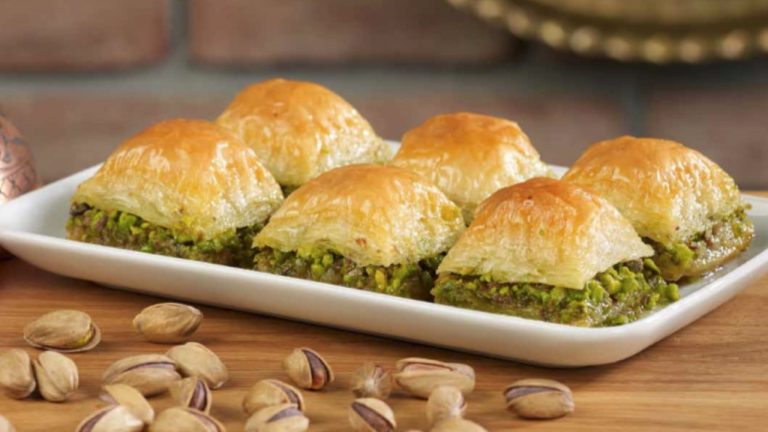When it comes to world-famous desserts, Turkish baklava stands out as a timeless delicacy that has captivated palates for centuries. Known for its rich history, intricate preparation, and irresistible flavor, baklava is a dessert that embodies the essence of Turkish cuisine. In this blog post, we’ll dive into the origins, ingredients, preparation, and cultural significance of baklava, exploring why it continues to be a favorite treat around the globe.
The Origins of Baklava: A Culinary Legacy
Baklava’s history is as layered as the dessert itself. While its exact origins are debated, it is widely believed that baklava traces back to the ancient Assyrians, who around the 8th century B.C. were already baking thin layers of dough with nuts and honey. Over time, this early version of baklava made its way to the kitchens of the Ottoman Empire, where it evolved into the sophisticated pastry we know today.
The Ottoman Turks refined the recipe by introducing phyllo dough, a key ingredient that gives baklava its characteristic flakiness. This delicate dough, combined with the finest nuts and a sweet syrup, transformed baklava into a luxurious dessert that was often reserved for royalty and special occasions. Today, baklava is a staple in Turkish households and a beloved treat enjoyed by people from all walks of life.
Ingredients: The Heart of Baklava
Creating the perfect baklava requires a careful selection of ingredients, each contributing to its unique flavor and texture. Here are the essential components:
Phyllo Dough
Phyllo dough, or “yufka” in Turkish, is the foundation of baklavas. This paper-thin dough is made from flour, water, and a small amount of oil or vinegar, rolled out into incredibly thin sheets. The dough’s delicate nature is crucial for achieving the signature crispiness of baklava.
Nuts
Nuts are the star of baklava’s filling. Traditionally, Turkish baklavas uses a combination of walnuts, pistachios, and sometimes hazelnuts. Each type of nut brings its own distinct flavor and texture, with pistachios being particularly prized for their vibrant green color and rich taste.
Sweet Syrup
The syrup, or “şerbet,” is what binds the layers of baklavas together and gives it its luscious sweetness. Made from sugar, water, and lemon juice, the syrup is poured over the baked pastry, allowing it to soak into the layers and infuse them with flavor. Some variations also include rosewater or orange blossom water for an added aromatic touch.
Butter
Butter is used generously between the layers of phyllo dough, ensuring that each layer bakes to a golden, crispy perfection. Clarified butter, or “sade yağ,” is often preferred for its pure, rich taste.
The Art of Making Baklava: A Labor of Love
Baklava is renowned not only for its taste but also for the meticulous process required to make it. Here’s a step-by-step overview of how this exquisite dessert is crafted:
1. Preparing the Phyllo Dough
While store-bought phyllo dough is available, traditional baklavas is made with homemade dough. This involves mixing the ingredients and rolling out the dough until it is almost translucent. Each sheet is then carefully laid out, ready for layering.
2. Layering and Filling
A large baking tray is greased with butter, and the layering begins. Several sheets of phyllo dough are placed on the tray, each brushed with melted butter. Once a substantial base is formed, a generous layer of finely chopped nuts is spread evenly. This process is repeated, alternating between layers of dough and nuts, until the tray is filled.
3. Cutting and Baking
Before baking, the layered dough is cut into diamond or square shapes. This ensures that the syrup can penetrate each piece thoroughly. The baklava is then baked in a preheated oven until it turns golden brown and crispy.
4. Adding the Syrup
Once the baklavas is out of the oven, hot syrup is poured over it. The pastry is left to cool, allowing the syrup to be absorbed completely. This step is crucial for achieving the perfect balance of sweetness and texture.
Cultural Significance: Baklava Beyond Borders
Baklava is more than just a dessert; it is a symbol of hospitality and celebration in Turkish culture. It is often served during festive occasions such as weddings, religious holidays, and family gatherings. Sharing baklava is a gesture of goodwill and a way to bring people together.
The popularity of baklava has transcended Turkish borders, making its way into various Middle Eastern, Mediterranean, and Balkan cuisines. Each region has its own unique twist on the recipe, reflecting local tastes and ingredients. Despite these variations, the essence of baklava remains the same: a sweet, nutty pastry that delights the senses.
Savoring the Sweetness of Turkish Baklava
Turkish baklava is a dessert that embodies the rich culinary heritage of Turkey. Its intricate preparation, high-quality ingredients, and cultural significance make it a beloved treat that continues to enchant dessert lovers worldwide. Whether enjoyed with a cup of Turkish tea or shared among friends and family, baklava is a testament to the enduring appeal of traditional Turkish cuisine. Indulging in a piece of baklava is not just about tasting a dessert; it’s about experiencing a slice of history and a moment of sweetness that transcends time and place.

